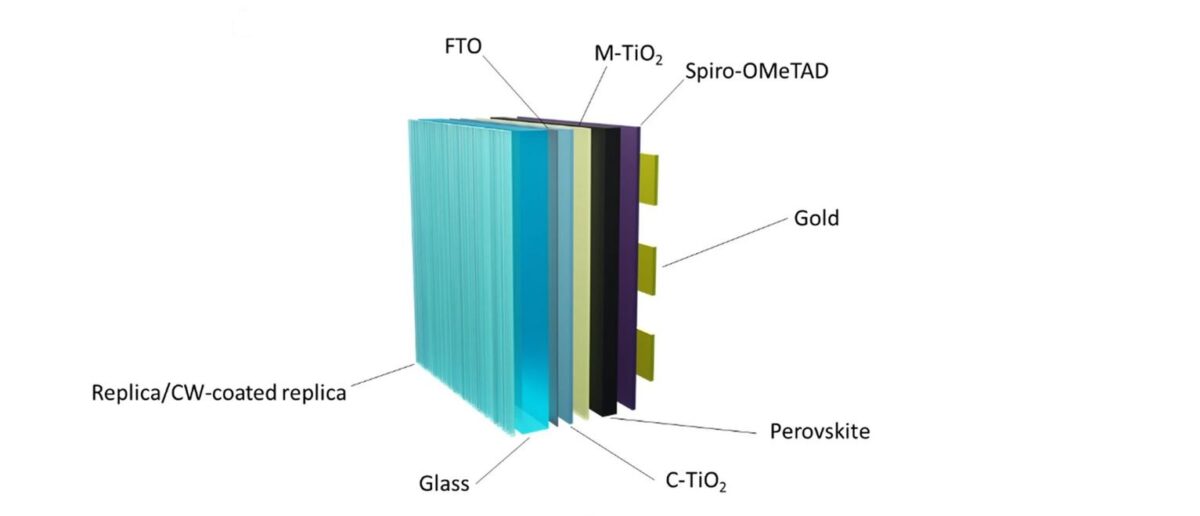A research team at Aalto University in Finland has developed a perovskite solar cell based on a “light management layer” made of a polymer material with the surface of leek leaves that can reportedly improve the device efficiency by up to 6%.
The scientists explained that the bio-inspired layer has self-cleaning properties. “The films’ self-cleaning can maintain the panels' efficiency over time by washing away dirt and dust that can block light,” said Aalto University researcher, Hamidreza Daghigh Shirazi, in a behind-the-paper article published by Springer Nature.
“In terms of optical properties, the replicated films show a high total transmittance of light, and furthermore, the film’s structure contributes to forward scattering of light which is also known for improving the efficiency of some solar energy technologies.”
To create the film, the researchers used a substrate fabrication method that replicates the surfaces of any leaf or patterned surface on cellulose acetates (CA). They initially explored a variety of plants and replicated their surface structures in cellulose films.
“While the exotic lotus leaf is often a source of bioinspiration for self-cleaning, many common garden plants, such as leek, possess desirable surface properties,” they noted. “Leeks have self-cleaning leaves due to their surface microstructure and natural wax layer. This combination allows water droplets to roll off easily, cleaning dust and dirt in the process.”
The group used leek leaves measuring 5 cm × 5 cm as a mold master. Then a monomer-to-crosslinking agent, known as polydimethylsiloxane (PDMS), was cast on top, followed by room temperature curing, and a tuning step to adjust the cellulose acetate solutions in three different concentrations.
To reach the desired level of hydrophobicity required for efficient self-cleaning, the scientists added a bio-based carnauba wax (CW), which is reportedly the hardest natural wax with the highest melting point among commercial vegetable waxes.
The leek leaf replicas were then glued on top of the cell's glass substrate. Immediately after drying, the I–V characteristics were measured. The averages and standard deviations were then reported from seven devices for each sample.
The academics built the solar cell with a substrate made of glass and fluorine-doped tin oxide (FTO) coated with the new film, an electron transport layer (ETL) made of titanium oxide (TiO2), a perovskite absorber, a hole transport layer (HTL) based on Spiro-OMeTAD, and a gold (Au) metal contact.
The cell was then tested under standard illumination conditions and its performance was compared to that of a reference device without the replica film. The coated cell achieved a power conversion efficiency of 14.2%, an open-circuit voltage of 1.07 V, a short-circuit current density of 18.7 mA cm−2, and a fill factor of 71.0%. The reference device obtained an efficiency of 13.4%, an open-circuit voltage of 1.05 V, a short-circuit current density of 18.3 mA cm−2, and a fill factor of 69.2%.
“Despite the lower transmittance of the CW-coated replica, in a trade-off between optical transparency and superhydrophobicity/self-cleaning, the developed films as the light management layer can ensure the performance of photovoltaics over time,” the scientists said. “Meanwhile, the surface water repellency facilitates self-cleaning, ensuring maximum incident light over time by tackling dirt accumulation.”
The details about the new film and the solar cell architecture can be found in the paper “Bio-inspired surface structures promote optical transmittance and hydrophobicity in cellulose-based films for self-cleaning perovskite solar cells,” published in Communications Materials.
This content is protected by copyright and may not be reused. If you want to cooperate with us and would like to reuse some of our content, please contact: editors@pv-magazine.com.



By submitting this form you agree to pv magazine using your data for the purposes of publishing your comment.
Your personal data will only be disclosed or otherwise transmitted to third parties for the purposes of spam filtering or if this is necessary for technical maintenance of the website. Any other transfer to third parties will not take place unless this is justified on the basis of applicable data protection regulations or if pv magazine is legally obliged to do so.
You may revoke this consent at any time with effect for the future, in which case your personal data will be deleted immediately. Otherwise, your data will be deleted if pv magazine has processed your request or the purpose of data storage is fulfilled.
Further information on data privacy can be found in our Data Protection Policy.